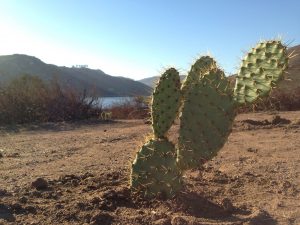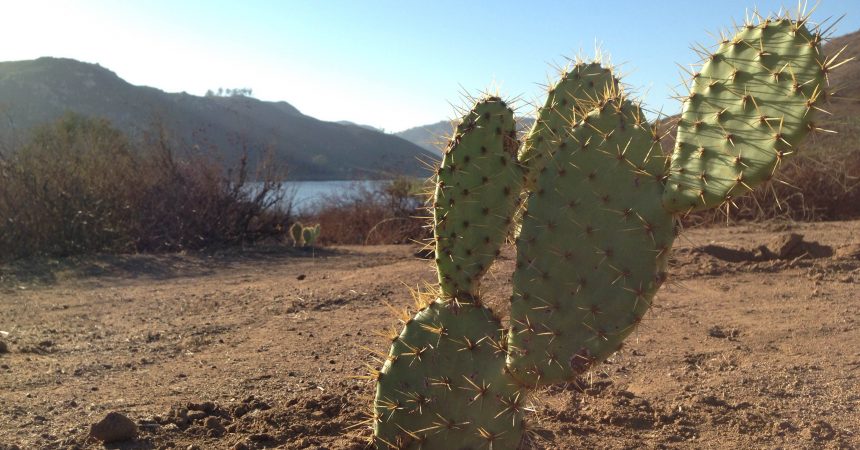Zoo InternQuest is a seven-week career exploration program for San Diego County high school juniors and seniors. Students have the unique opportunity to meet professionals working for the San Diego Zoo, Safari Park, and Institute for Conservation Research, learn about their jobs, and then blog about their experience online. Follow their adventure here on the Zoo’s website!
 A meeting with Ryan Fitch at Lake Hodges was the destination for the interns this week. Lake Hodges is a sanctuary for many local species residing in the endangered coastal sage scrub habitat. As a watershed controlled by San Diego County, the Lake Hodges preserve will never be developed for housing. Currently, Mr. Fitch serves San Diego Zoo Global as a Research Associate in Plant Conservation. His work helps restore native habitats by planting and maintaining native shrubs and removing invasive species at local restoration sites. At Lake Hodges preserve, his main restoration site, he has planted 20,000 native coastal sage scrub shrubs across 25 acres over two years. Mr. Ryan’s main goal is to create a wildlife corridor stretching from Lake Hodges to Julian protecting San Diego’s diverse wildlife.
A meeting with Ryan Fitch at Lake Hodges was the destination for the interns this week. Lake Hodges is a sanctuary for many local species residing in the endangered coastal sage scrub habitat. As a watershed controlled by San Diego County, the Lake Hodges preserve will never be developed for housing. Currently, Mr. Fitch serves San Diego Zoo Global as a Research Associate in Plant Conservation. His work helps restore native habitats by planting and maintaining native shrubs and removing invasive species at local restoration sites. At Lake Hodges preserve, his main restoration site, he has planted 20,000 native coastal sage scrub shrubs across 25 acres over two years. Mr. Ryan’s main goal is to create a wildlife corridor stretching from Lake Hodges to Julian protecting San Diego’s diverse wildlife.
San Diego County is home to rich habitats including coastal sage shrub and chaparral. The coastal sage scrub covers much of the county; from the coast to the foothills around 1,500 feet in elevation. Throughout the county there are small pockets of protected habitat including Torrey Pines State Park and the Safari Park. The denser chaparral located at the Safari Park and Camp Pendleton, take over from the coastal sage scrub at elevations of 1,000 to 4,500 feet. San Diego County shelters over 200 imperiled plants and animals, more than any other county in the United States. Endangered species living in San Diego County include the gnatcatcher, the Arroyo southwestern toad; Stephens’ kangaroo rats, and the cactus wren. With all the new development in the county, we need to remember that our wildlife also deserves to retain their residence in our local habitat.
The interns helped Mr. Fitch achieve his goal by planting a hundred cacti in order to protect the cactus wren. According to the North American Breeding Bird Survey, the cactus wren is an endangered local bird; 55% of its population has diminished between 1966 to 2015. Before the interns got their hands dirty, Mr. Fitch talked about the cactus wren and how the San Diego Institute for Conservation Research is aiding in the recovery of their depleting numbers. Over two years, Mr. Fitch and his team of volunteers have planted thousands of Opuntia cactus across the Lake Hodges preserve. The Opuntia cactus, also known as prickly pear cactus, is the home for the cactus wren and offers protection from unwanted predators including the ferocious falcons and hawks. After the informative discussion, interns and Mr. Fitch hiked to the restoration site located a half-mile from the trailhead. Once there, the interns put on protective gloves and unloaded the truck filled with cactus. Unfortunately, the prickly needles made transporting the cactus a challenge. Once each cactus was transported, the interns planted the cactus and filled the remaining hole with dirt, which Mr. Fitch was kind enough to dig the day before. The whole planting took a little over an hour, leaving us pricked, worn down, and covered in dirt. Surveying the rows of newly planted cactus, we realized every cactus planted helped a cactus wren and further understood that Mr. Fitch’s work with the local wildlife helps to make a difference in stopping extinction every day.
San Diego’s wildlife is shrinking; only 10% of coastal sage scrub is left due to housing development, non-native plant species, and frequent fires. The public can be a part of saving the cactus wren by volunteering to help with planting and maintaining native shrubs and removing invasive species. To volunteer this fall 2016 or winter 2017, email appliedplant@sandiegozoo.org for more information. If you are not able to volunteer, there are simple and effective ways to help conserve our local wildlife. Cat owners need to understand the importance of keeping cats indoors. Outdoors, cats are a non-native and invasive species that threaten birds and other wildlife, disrupt ecosystems, and spread diseases. Cats kill approximately 2.4 billion birds every year in the U.S. alone, making cats by far the largest human-caused mortality threat to birds. If you are an avid hiker, it is important to stay on the trail to help preserve the wildlife. When we walk on soil, our body weight compresses the soil making water and air travel slower through the soil, which ultimately, harms plants. Finally, you can spread the word about conservation and ways in which humans affect the environment.
Kristofer, Real World
Week Five, Fall Session 2016


